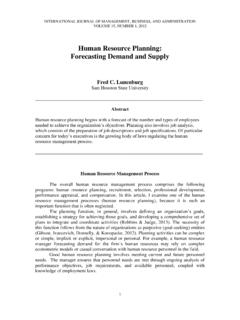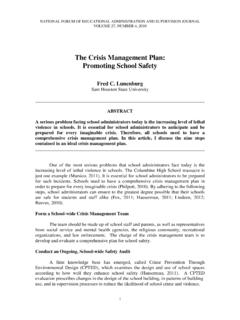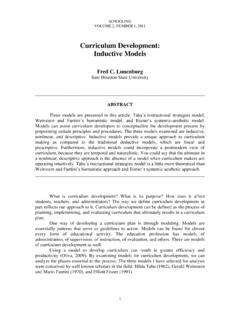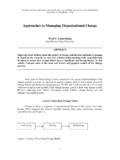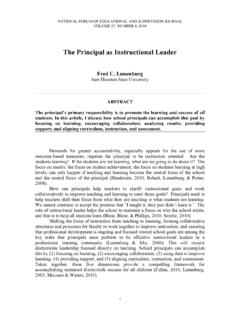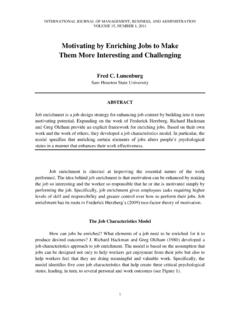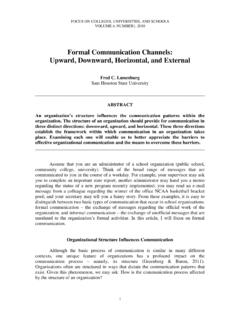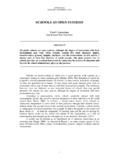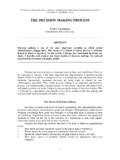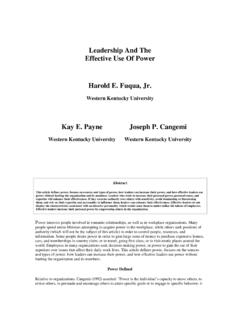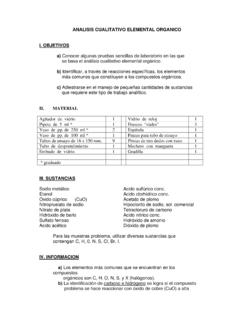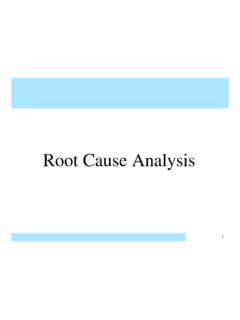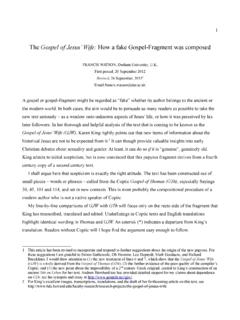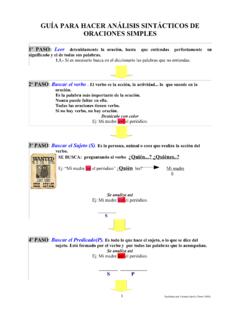Transcription of Emotional Intelligence in the Workplace: Application to ...
1 INTERNATIONAL JOURNAL OF MANAGEMENT, BUSINESS, AND ADMINISTRATION VOLUME 14, NUMBER 1, 2011 1 Emotional Intelligence in the Workplace: Application to Leadership Fred C. Lunenburg Sam Houston State University ABSTRACT Traditionally, Intelligence was viewed as cognitive mental ability consisting primarily of two relatively narrow dimensions: mathematical/logical and verbal/linguistic, or IQ. Howard Gardner expanded this narrow perspective to include multiple intelligences. Later, Daniel Goleman introduced a new kind of ability, Emotional Intelligence (EI), the capacity for understanding one s own and others emotions.
2 The multiple intelligences construct, and Emotional Intelligence in particular, have received a great deal of attention recently, particularly with respect to leadership capacity. There is some evidence that the characteristics of EI ( , self-awareness, self-management, self-motivation, social awareness, and relationship management) may be a better predictor of leadership performance and success than the traditional Intelligence quotient, or IQ. When most people speak about Intelligence , they are generally referring to cognitive ability, Intelligence quotient , or IQ. More than a century ago, Alfred Binet developed a written test to measure the IQ of elementary school children in France.
3 Later the Armed Forces began using the test with recruits in World War I. Subsequently, it was used widely in schools and businesses to classify students and select employees, respectively. IQ was assumed to be genetic. This notion of Intelligence was unchallenged as a predictor of school and job success for many years. However, in recent years, there has been a debate concerning whether or not Intelligence is fixed at birth (Cooper, 2012; Marrin, 2011; Sternberg, 2011). In 1983, Howard Gardner published a breakthrough book, Frames of Mind: The Theory of Multiple Intelligences. The Binet IQ Test (Stanford-Binet IQ Test) basically measured two traditional cognitive ability dimensions: mathematical/logical and verbal/linguistic, which were thought to determine Intelligence .
4 Gardner recognized these two dimensions and added five others: interpersonal, intrapersonal, visual/spatial, musical, and bodily/kinesthetic (Gardner, 1983). In developing these seven multiple intelligences (MIs), he reasoned that Intelligence was not entirely fixed at birth, but it could be developed. Gardner (2008, 2011a) added three new intelligences to the original INTERNATIONAL JOURNAL OF MANAGEMENT, BUSINESS, AND ADMINISTRATION 2_____ seven: naturalist, existential, and Emotional . Many educators have used the MI paradigm in schools and classrooms (Gardner, 1993, 2011b). Emotional Intelligence : A New Kind of Ability Building on the work of Howard Gardner s multiple intelligences is the more recent emergence of Emotional Intelligence .
5 It was the publication of Daniel Goleman s (1995) best-selling book Emotional Intelligence that popularized the construct. Goleman defines Emotional Intelligence , or EI, as the ability of an individual to know one s emotions, manage them, motivate one s self, recognize emotions in others, and manage relationships with others (Goleman, 1995). According to Goleman (1995, 1998), the key dimensions of Emotional Intelligence in the workplace include: self-awareness, self-management, self-motivation, social awareness, and relationship management. Self-Awareness The ability to understand one s own emotions is the most essential of the Emotional Intelligence dimensions.
6 Having high self-awareness allows people to know their strengths, weaknesses, values, and motives. People with high self-awareness can accurately measure their own moods and intuitively understand how their moods affect others; are open to feedback from others on how to continuously improve; and are able to make sound decisions despite uncertainties and pressures. They are able to show a sense of humor. A leader with good self-awareness would recognize factors such as whether he or she was liked, or was exerting the right amount of pressure on organization members. Self-Management Self-management refers to how well we control our emotions, impulses, and resources.
7 It includes keeping disruptive impulses in check; displaying honesty and integrity; being flexible in times of change; maintaining the drive to perform well and seize opportunities; and remaining optimistic even after failure. A leader with high self-management would not suddenly decide to fire a team member because of one difference of opinion or throw a temper tantrum when activities do not go as planned. Self-Motivation Self-motivation refers to being results oriented and pursuing goals beyond what is required. Highly self-motivated people set challenging goals for themselves and others; seek ways to improve their performance; and readily make personal sacrifices to meet the organization s goals.
8 They harness their emotions and employ them to improve their chances of being successful in whatever they are seeking to accomplish. They operate from hope of success rather than fear of failure. For example, consider an author who is struggling to finish a book with a contract deadline with the publisher. The author who is FRED C. LUNENBURG _____3 high in self-motivation would likely encourage herself to work hard through bouts of writer s block. In contrast, an author low in self-motivation might begin to doubt her competence as a writer, engage in self-defeating thoughts, and withdraw from the project.
9 Social Awareness Social awareness refers to having understanding and sensitivity to the feelings, thoughts, and situations of others. This includes understanding another person s situation, experiencing the other person s emotions, and knowing their needs even when unstated. Socially aware leaders go beyond sensing the emotions of others by showing that they care. In addition, socially aware leaders have the ability to sense office politics and understand social networks. They are good at acknowledging people s strengths, accomplishments, and development. For example, a team leader with high social awareness would be able to assess whether a team member has enough enthusiasm for a project to assign him to that project.
10 A CEO who has understanding and sensitivity for a labor union s demands might be able to negotiate successfully with the head of the labor union to avoid a costly strike. Relationship Management Relationship management refers to guiding other people s emotions. It includes inspiring others, influencing others beliefs and feelings, developing others capabilities, managing change, resolving conflicts, building strong personal bonds, supporting teamwork, and leading by example. These practices require the ability to communicate clearly and convincingly, with the purpose of influencing others. A leader with good relationship-management skills is good at persuading others to share her vision and would continually enlarge her network of people to win their support when support is needed.
